Scholars often do not read documents in their original format. To the contrary, they peruse them in printed compilations, the oldest being Dainihon shiryō (大日本史料), a chronological compendium of sources published by the Tokyo University Historiographical Institute. The compilation and editing of these sources took decades, with the first volume published in 1901, and the project continues to this day. Many people refer to this monumental compendium, and other sources published by the Tokyo University Historiographical Institute, but few know the process by which the sources are compiled and transcribed. Insight into this process of copying and printing is offered by a document of praise by Ōuchi Yoshioki, dated to 1511 and now owned by Princeton, that has retained several related rare letters and envelopes that tell its history of ownership and transmission. In this short essay, I will track the remarkable history of this single document.
The 1511 document is of unknown provenance. It was written in an unusual style, with the recipient mentioned in the body of the text, rather than at the end. In this case, the document’s recipient was Shinohara Nagamori. No other supporting records exist from 1511, although the historian Wada Shūsaku has pointed out that its format is consistent with other records in the Shinohara collection, which appear in volume (maki) 150 of the Hagi han batsu etsu roku. Wada Shūsaku also reported that a forged document from the shogun Ashikaga Yoshitane once accompanied this document. Evidence indicates that the 1511 document was one of fourteen that in 1915 belonged to a certain “Nakajima,” who resided in Shimane Prefecture. At that time the fourteen documents were carefully copied by hand in a format known as an eishabon (影写本) by someone at the Shimane Prefectural Library. Most of the documents in the Nakajima collection are letters that date from the Tokugawa era (1615-1868), but two can be verified as dating from the sixteenth century.
The second oldest document does not refer to the year of its writing, making it difficult, but not impossible, to date it. Recorded are the day and month—specifically the first intercalary month. Intercalary months were added to the Japanese lunar calendar as necessary to make it more accurate, functioning as a kind of leap month. Intercalary first months are relatively rare, and so the most plausible year for this record is 1572 (Bunki 3). This would place it after the period of Ōuchi collapse (1557), and at a time when the region was fought over by two rival warlords, the Mōri and the Amako. The Mōri first gained control of the harbor Yunotsu in 1562 (Eiroku 5), but their authority was at times tenuous, and when the Amako attacked them in 1570, for example, the Mōri had to build a castle, called Unomaru, to defend Yunotsu.
Surprisingly enough, the 1572 document does not have a clear connection to the Nakajima or the Shinohara at all. To the contrary, Mōri Terumoto, the lord of the region, confirmed the Yunotsu holdings of a person with the surname Komaki. This Komaki was ordered to perform otherwise unspecified duties “as had been customary.” What this means is not clear, but the duties were most probably associated in some way to the transportation of silver from the Iwami Silver mines to the port of Yunotsu, which was the only way that silver could be exported from the mines at that time. Whether the Komaki had some connection to the Shinohara is not known at this time.
Although the 1572 letter is a copy dating from 1915, evidence suggests that it is faithful to the original. Terumoto’s signature is consistent with that of other records of that time, and Terumoto can be documented as issuing this order through two retainers, Inoue Tajima no Kami Narishige and Hayashi Narinaga, who were in control of the silver mines. After the Amako attack, it is likely that the Mōri would have enlisted the support of old Ōuchi supporters such as the Komaki.
The fourth document in the sequence dates from 1579 (Tenshō 7) and describes a loan of 530 units of silver, to be paid back within five years, with a dwelling in Yunotsu used as collateral. Perhaps this is when the Komaki holdings became part of the Nakajima patrimony, because if a loan could not be repaid, the lands and their related documents would pass to the new owner. Although several letters survive from the Tokugawa era in the Nakajima collection, the story that they tell remains obscure, and so the fate of the Komaki and the precise transmission of the 1511 letter are unknowable.
By 1894 (Meiji 27), Nakajima Tetsujirō, the head of the Nakajima house at the time, loaned the 1511 Ōuchi Yoshioki document to the Tokyo Historiographical Institute, where it was carefully copied as an eishabon for future reference for the Dainihon shiryō. This is known because an exact copy survives from that year in their archives. Furthermore, an envelope is addressed to Nakajima Tetsujirō (see below), which presumably dates from 1894, survives as well.
The Shimane Prefectural Library copied the Nakajima documents some twenty years later on 12.10.1915 (Taishō 4), and there, and only there, the eishabon of the fourteen documents in the Nakajima collection can be found.
Although the Historiographical Institute had already borrowed the 1511 Ōuchi Yoshioki document in 1894, when the publication date for the relevant volume of the Dainihon shiryō approached, the editors once again borrowed it. The head of the Nakajima house was no longer Nakajima Tetsujirō, but a certain Nakajima Heizaemon, presumably Tetsujirō’s son.
Copyists at the Historiographical Institute made a second eishabon of the 1511 document in 1930 (Shōwa 5). They copied only this record, but ignored the other documents of the Nakajima collection. The second envelope, postmarked 3.25.1930 (Shōwa 5), suggests that the document was returned to Nakajima Heizaimon in Yunotsu on 3.27.1930. Nevertheless, Tsuji Zennōsuke’s letter thanking Nakajima Heizaimon was not sent until 4.10.1931. Volume 3 of the ninth series of the Dainihon shiryō was published in 1932 (Shōwa 7). There, on page 66, the 1511 Ōuchi Yoshioki letter appears in print for the first time, and is described as part of the “Nakajima Heizaimon collection.”
 This is the original document from Ōuchi Yoshioki to Shinohara Nagamori. It is in an unusual format, but one typical for the Ōuchi when they issued important documents to the Shinohara. At some time multiple families gain possession of a prestigious document and it ended up with families linked to Nima district in Iwami Province. The Yunotsu area encompassed ports that were used for the export of silver from the nearby silver mines. For more on this, see the section “Sea Lords.”
This is the original document from Ōuchi Yoshioki to Shinohara Nagamori. It is in an unusual format, but one typical for the Ōuchi when they issued important documents to the Shinohara. At some time multiple families gain possession of a prestigious document and it ended up with families linked to Nima district in Iwami Province. The Yunotsu area encompassed ports that were used for the export of silver from the nearby silver mines. For more on this, see the section “Sea Lords.”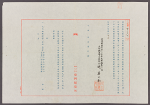
On 4.10.1931, Tsuji Zennōsuke, head of the Tokyo Historiographical Institute, wrote to Nakajima Heizaemon, thanking him for the loan of the 1511 Ōuchi Yoshioki letter. Tsuji mentioned that the Institute had held the Yoshioki letter for a long time, but perhaps he was mistaken, as a surviving envelope (see below) suggests that the document had been returned in 1930, with this letter of appreciation being dispatched the following year. The 1511 document was sent in regular mail separately from this letter.
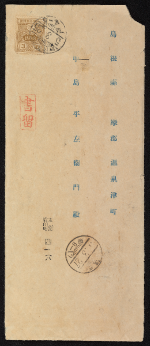
 This registered envelope was sent from Tsuji Zennōsuke to Nakajima Heizaemon and contained the 1511 Ōuchi Yoshioki letter. Nowadays, such letters are so valuable that it would be inconceivable to send them via regular mail. The envelope was postmarked on 3.25.1930 (Showa 5) and arrived in Nima in Shimane Prefecture, two days later. The document that the Historiographical Institute copied in 1930 was sent back to Nakajima Heizaemon in 1930, but the letter of thanks was not dispatched until the following year.
This registered envelope was sent from Tsuji Zennōsuke to Nakajima Heizaemon and contained the 1511 Ōuchi Yoshioki letter. Nowadays, such letters are so valuable that it would be inconceivable to send them via regular mail. The envelope was postmarked on 3.25.1930 (Showa 5) and arrived in Nima in Shimane Prefecture, two days later. The document that the Historiographical Institute copied in 1930 was sent back to Nakajima Heizaemon in 1930, but the letter of thanks was not dispatched until the following year.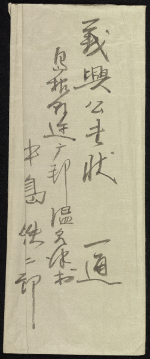
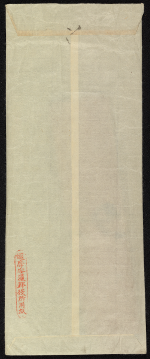 This envelope is addressed to Nakajima Tetsujirō, and undoubtedly is linked to the earlier 1894 loan of the document. Save for the fact that Tetsujirō relied on an envelope from the district office of Nima, in Shimane Prefecture, and that a copy dating from 1894 survives at the Historiographical Institute, little is known about this earlier exchange.
This envelope is addressed to Nakajima Tetsujirō, and undoubtedly is linked to the earlier 1894 loan of the document. Save for the fact that Tetsujirō relied on an envelope from the district office of Nima, in Shimane Prefecture, and that a copy dating from 1894 survives at the Historiographical Institute, little is known about this earlier exchange.

This is one of the two identical copies of the original 1511 Ōuchi Yoshioki document. It is called an eishabon, which means a shadow copy. Original documents would be placed underneath a glass desk, and a calligrapher would exactly copy the original document. Skilled examples, like this example here, would be flawless and virtually indistinguishable from the original. Here one can see how closely an eishabon resembles the original document, complete to its careful reproduction of the monogram. In cases where a copyist made errors, the problematic portions would be circled in red, but this copy is good enough that such corrections were not needed. Both Historiographical Institution copies of the 1511 letter are virtually identical, so we reproduce only one here.
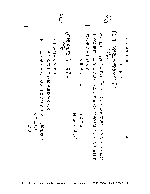 Here is a pdf of page 66 of Dainihon shiryō Series 9 volume 3 (1932). One can see that the document was carefully transcribed and listed as being part of the Nakajima Heizaimon document collection. In other words, the name of the current owner and the place of his residence was written in the margins of the book. Ōuchi Yoshioki’s monogram is mentioned in the transcription, without reproducing its image. To examine the monogram of Ōuchi Yoshioki, one would have had to either examine the original or view the two eishabon at the Tokyo Historiographical Institute.
Here is a pdf of page 66 of Dainihon shiryō Series 9 volume 3 (1932). One can see that the document was carefully transcribed and listed as being part of the Nakajima Heizaimon document collection. In other words, the name of the current owner and the place of his residence was written in the margins of the book. Ōuchi Yoshioki’s monogram is mentioned in the transcription, without reproducing its image. To examine the monogram of Ōuchi Yoshioki, one would have had to either examine the original or view the two eishabon at the Tokyo Historiographical Institute.